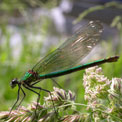The NaturePlus Forums will be offline from mid August 2018. The content has been saved and it will always be possible to see and refer to archived posts, but not to post new items. This decision has been made in light of technical problems with the forum, which cannot be fixed or upgraded.
We'd like to take this opportunity to thank everyone who has contributed to the very great success of the forums and to the community spirit there. We plan to create new community features and services in the future so please watch this space for developments in this area. In the meantime if you have any questions then please email:
Fossil enquiries: esid@nhm.ac.uk
Life Sciences & Mineralogy enquiries: bug@nhm.ac.uk
Commercial enquiries: ias1@nhm.ac.uk
Manage categories
Add a new category
Edit category
CloseCreate and manage categories in Dragonflies and damselflies. Removing a category will not remove content.
Categories in Dragonflies and damselflies
Manage Announcements
Add a new announcement
Edit Announcement
CloseCreate and manage announcements in Dragonflies and damselflies. Try to limit the announcements to keep them useful.
Announcements in Dragonflies and damselflies
| Subject | Author | Date | Actions |
|---|
Enter your announcement details below, including when you would like it to become active and expire. By default, announcements will become active immediately and expire in 7 days.
 Loading...
Loading...
About dragonflies and damselflies

Dragonflies and damselflies are both groups of insects.
Dragonflies and damselflies form the group called Odonata. They are recognisable as long-bodied insects with two pair of large, stiff wings and large eyes. The antennae are conspicuous and very small.
As adults and larvae they are voracious predators of other invertebrates. The larval stage is confined to water and some common species are commonly found in the smallest of garden ponds. The adults of the less robust damselflies do not usually venture far from water. Larger dragonflies are capable of more powerful flight and are often seen hawking for insect prey considerable distances from ponds, streams or rivers.
Number of UK species: about 60
Whats new?
Refresh this widgetWho we are
These forums are looked after by scientists and experts in the Museum’s Identification and Advisory Service.
Our fossil, rock, plant and insect experts are dedicated to answering your natural history questions.
Our names on this forum are:
Former team members:
Related information
Top participants
The top participants are currently being calculated or no one has contributed yet.
- Contact and enquiries
- Accessibility
- Website terms of use
- Information about cookies
- © The Trustees of the Natural History Museum, London


